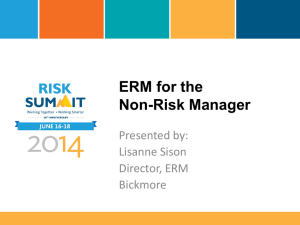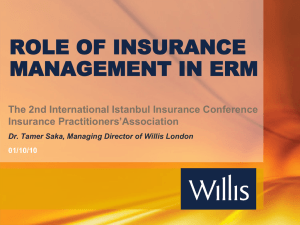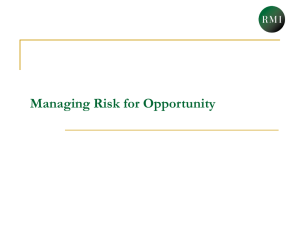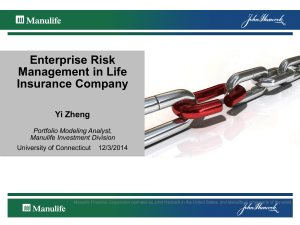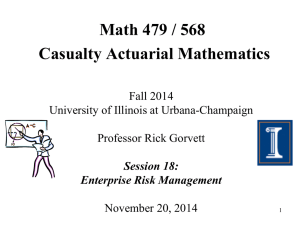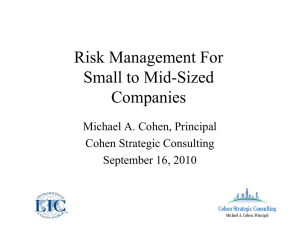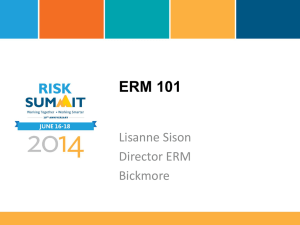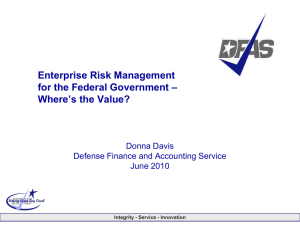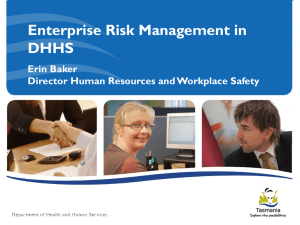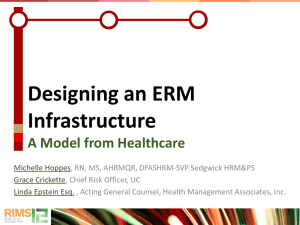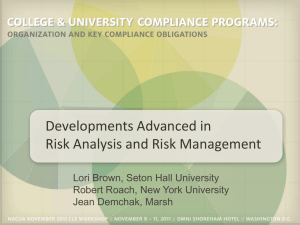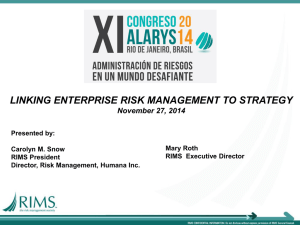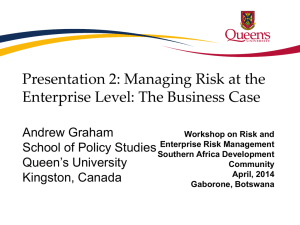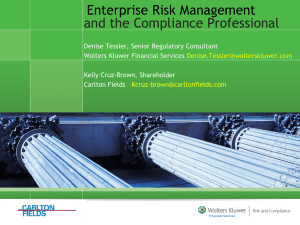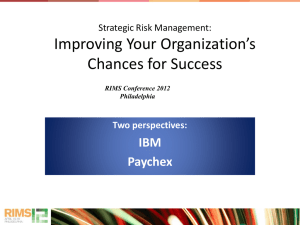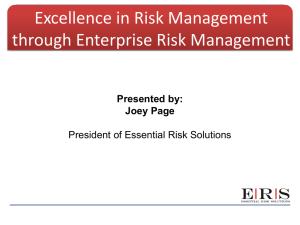File
advertisement
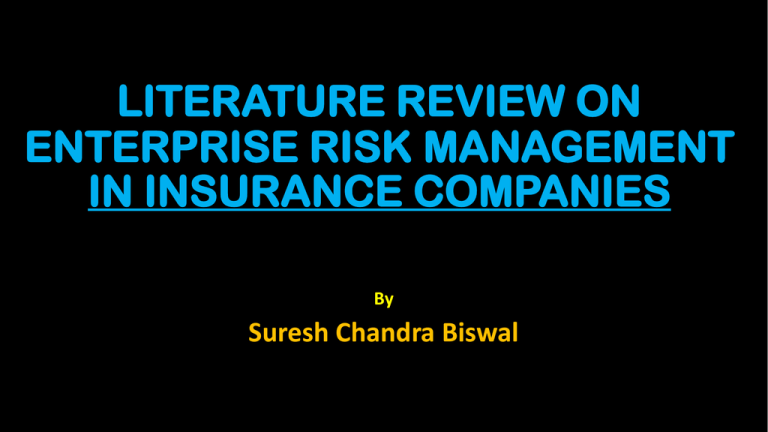
LITERATURE REVIEW ON ENTERPRISE RISK MANAGEMENT IN INSURANCE COMPANIES By Suresh Chandra Biswal Introduction: Definition of Risks: Risk is often thought of in terms of chance of loss. Risk can be defined as the degree of variations in the possible outcome from an uncertain event or as the variations in actual from expected outcome. Definition of Risk Management: Risk management refers to a process of identifying loss exposures faced by an organisation and selecting the most appropriate techniques for treating this particular exposures effectively(Radeja,2003). Risk management is the identification, assessment and prioritization of risks followed by coordinated and economical applications of resources to minimize, monitor and control the probability and/or impact of unfortunate events or to minimize the realisation of opportunities.(Wenk,2005) Goals of Risk Management: Risk Management is the process of determining how to handle the pure risks to which an individual, family or entity is exposed with the following goals: Survive the loss event; Have peace of mind; Reduce total risk management cost and thus have general higher profits; Stabilize earnings; Have little or no interruption in operation; Have continued growth and; Help carry out the individual's or entity's sense of social responsibility or desire for a good image Literature Review Risk Management Literature has attempted to distinguish between different methods adopted by Companies in managing their business risk and evaluating their effectiveness. Two main schools of thought have emerged from the literature; the silo approach which focuses to manage risk in isolation (e.g. market risk, credit risk etc.) and the alternative approach to manage all risks in a single and holistic framework. The latter is termed as ERM(Nacco, 2006). Liebenberg & Hoyt (2003): ERM enables organizations to take advantage of a broad and integrated approach to risk management which is more offensive and strategic unlike the silo-based risk management which was primarily a defensive method of managing risk. The clearest definition of ERM which comes term the inventor of an ERM framework defines it as; “A process effected by an entity's board of directors, management and other personnel applied in strategy setting and across the enterprise, designed to identify potential events that may affect the entity and manage risk to be within its risk appetite to provide reasonable assurance regarding the achievement of entity objectives.(COSO, 2004)” According to Tseng (2007), Enterprise Risk Management(ERM) is a framework that focuses on adopting a systematic and consistent approach to managing all of the risks confronting an organisation. Gordon et al.(2009) on the other hand define ERM as the overall process of managing an organization's exposure to uncertainty with particular emphasis on identifying and managing the events that could potentially prevent the organization from achieving its objective. Among the early literature of ERM is a conceptual paper by Miller(1992). He argues that the isolated treatment of uncertainties in the existing management literature does not provide an adequate basis for analyzing the risk implications of strategic decisions. In contrast, the integrated risk management perspective provides a framework for identifying and assessing the many types of uncertainties relevant to strategy formulation(Miller, 1992). In subsequent period, some empirical study were conducted to identify the financial characteristics of companies which adopted ERM. The study led by (Liebenberg & Hoyt,2003) found that highly leveraged firms are more inclined to adopt ERM. Pagach and Warr(2007) who also used the same methodology of CRO announcement to identify companies with ERM found that firms that are more leveraged have more volatile earnings and have exhibited poorer stock market performances are more likely to initiate an ERM programme when the value of the CEO's option and stock portfolio is increasing in stock volatility, the firm is more likely to adopt ERM. Lin, Wen and Yu(2012) found that insurers with higher reinsurance ratio and greater geographical diversification are more likely to implement ERM. The other group of researchers looked at the determinants for ERM adoption which include various factors like regulatory influences(Paape & Speckle 2012), ownership (Liebenberg & Hyot, 2003; Pape & Speckle, 2012; Pagach & Warr, 2007) appointment of big four audit firms( Beasley, Clune & Hermanson,2005, Paape & Speckle,2012); firm and industry related characteristics as well as business complexities (Gordon Loeb & Tseng, 2009; Lin et al., 2012; Pape & Speckle,2012); Board of Directors(Gordon et al., 2009; Muralidhar, 2010; Wan Daud, Haron & Ibrahim, 2011; Yazid, Hussin & Wan Daud, 2011) country of origin – US based vs. non-US based (Beasley et al; 2005; Liebenberg & Hyot, 2003), firm size(Gordon at al, 2009). Among the early studies on factors that affect the ERM adoption within the organizations i.e. one by Kleffner Lee & McGannon(2003). It was found that almost a third of the respondents have adopted ERM and the larger portion of the remaining is moving towards that direction. Among the reasons cited for adopting ERM includes the influence of Risk Manager, encouragement from BOD and compliance with Stock Exchange Requirements with major deterrents being organizational structure and overall resistance to change. In a later study by Beasley at al.(2005), it was suggested that board and senior management leadership on ERM is critical to extensive ERM deployment. Other organizational characteristics such as size, auditor type, industry and country of domicile also explain the extent of ERM implementation. Waweru & Kisaka,2013; Hyot & Liebenberg,2011): A couple of studies using secondary data finds significant relationship between a Company's level of Enterprise Risk Management implementation and the Company's value. Support from the senior management team namely CEO(Beasley et al, 2005, Muralidhar 2010), CFO of the entity( Beasley at al, 2005), internal auditors(Beasely et al,2005; Liu, 2012; Kasim, 2011; Wan Daud, 2011) as well as board of directors( Muralidhar,2010, Wan Daud et al.,2011) were also identified in the earlier studies as one of the drivers for adoptions. Arena et al.,2010,2011;Muralidhar,2010;Tekathen & Dechow,2013 in their studies investigated the ERM implementation process to understand in depth the ERM practices in the actual business environment. Research Methodology Most of literature reviewed consist of empirical, paper and the remaining were conceptual paper comprising predominantly quantitative studies followed by qualitative and a few mixed methods research design. Research Gap . The main gap in the literature is therefore believed to be in the wider social, institutional and organizational context in which if operates, rather than just focusing on the technical aspect of risk management, in particular in the operations of ERM within the actual organizational settings. No study has been done on impact of employee involvement throughout the whole process of ERM implementation and enforcement. The second gap is found in what's involved in implementing and managing a workable, effective and successful ERM.A few studies has investigated the conditions necessary for a successful ERM program. THANK YOU


